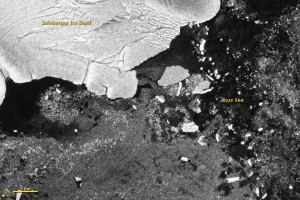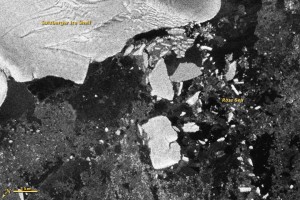You’re looking at the icy shores of Antarctica–8,000 miles from Japan.
It’s a place called the Sulzberger Ice Shelf.Â
This satellite image on the right was taken on March 11, 2011–just hours after that day’s great Japan quake and Tsunami. I want you to notice some of the pieces that are cracked–but still attached to the ice around it.
Now, take a look at the next image on the lower left.This is five days after the Tsunami hit Antarctica.Â
Many of those massive ice chunks that had been connected to the rest of the ice shelf are now miles and miles from where they’d been. They’ve become huge icebergs thanks to waves from the Japanese Tsunami.
A NASA summary of this event puts it like this: “Using satellite radar data, scientists recently observed the calving of several large icebergs from the Sulzberger Ice Shelf along the Antarctic coast as a result of the March 2011 tsunami half a world away in Japan. Scientists have long speculated that ocean waves could cause an ice shelf to flex and break, but this is the first time researchers have observed a tsunami having this effect.”
Researchers believe this swell from the tsunami was probably just about a foot high. But it moved an incredible amount of ice.
Says NASA: “Together, the broken chunks of ice equaled an area of 125 square kilometers, about two times the size of Manhattan Island in New York. According to historical records, the piece of ice that broke up on March 11 hadn’t budged for at least 46 years before the tsunami came along.”
Another way of putting it: picture half the city of Portland. That’s how big these ice chunks measured–broken off by the Tsunami!
Isn’t that amazing?



Leave a Reply